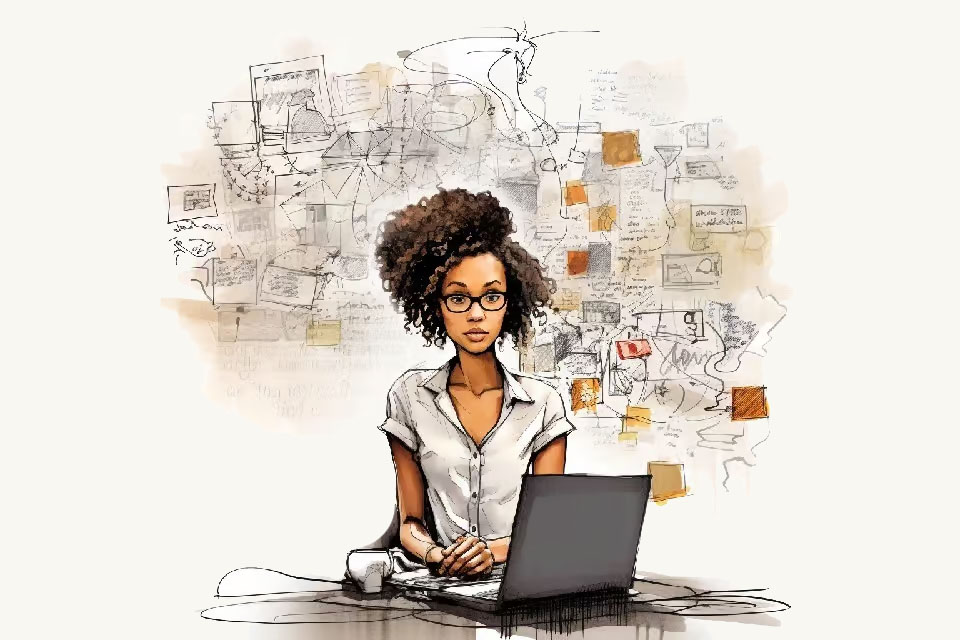6 components for building remote teams
How to enable people to work together in an appreciative and value-creating way
You may think what you like about Corona – but in any case you have had to learn how to use it over the past two years. And you have certainly found that you and your colleagues can also work efficiently and effectively in a home office.
It was no different for us at QLab: when we started our first Design Sprint in April 2021, we didn’t realise that our business model would be digital: Since then, however, five young professionals from all over the world have come together several times a year for five weeks as a remote team to find solutions for a company or a municipality to issues relating to “Liveable cities through green architecture/infrastructure and new mobility”.
This means that people who have never met before have to create value for our clients from day one. In this article, I would like to share with you the components with which we succeed in doing this.
The framework of collaboration
Imagine you need to assemble a team in a very short time to develop a new product, service or process for one of your clients. The collaboration takes place online. Your colleagues work in different locations, whether in a home office or in the office is irrelevant. Face-to-face meetings have not yet taken place.
This is where leadership is needed – the whole project stands and falls with a binding and experienced process facilitator and framework conditions in which the team can feel comfortable
- starting with onboarding,
- through kick-off,
- in the day-to-day collaboration,
- to project closure.
It is about empowering those involved to work together in an appreciative and value-creating way. Or to put it another way: It is about the 6 components for the successful development of remote teams.
Component #1: The onboarding process
In onboarding there are two possible scenarios here:
- Potential team members are asked to apply for the project.
- You have already selected the team members.
For both scenarios, you should ideally set up a team of no more than five people who have all the skills needed for the project.¹ And in both scenarios, the potential team members should be
- the potential team members should be technically experienced. Tip: Ask for the relevant skills and references.
- the potential team members apply with a letter of motivation in which they briefly describe the causal reason for wanting to work together.
Component #2: Before the start of the project
a) The basic task in consultation with the client is clear.
b) Provide your future team with all the necessary technical resources. We work for example with
- MS Teams and Outlook (video conferences, calendar, emails, documentation),
- WhatsApp (everything that is urgent goes through this channel, which is also available as a desktop application),
- Miro (our virtual creative team space),
- and Canva (our design and presentation programme, with which even non-designers can design). Several people can work in the documents at the same time.
- Deepl (translation programme),
- Grammerly (spelling programme),
- and Survey Monkey (survey programme).
c) Pictures are worth 1,000 words. Ask your future team members to introduce themselves at the kick-off in a Pecha Kucha based on personal questions² you have pre-written, using only pictures. This approach provides an insight into each other’s lives, activates empathy, change of perspective and storytelling skills.
d) Before the kick-off, we invite all project participants via MS Teams to our meetings, which might be familiar to some from the agile world: kick-off, daily, weekly, retrospective and project closure.
Component #3: The kick-off
a) We start our kick-off with the Pecha Kuchas (see #2c). Afterwards, we invite our clients to a briefing and a comparison of expectations. The team also introduces itself briefly in this context. At this point we also get the client’s consent to contact them at any time if they have any questions. Ideally, the contact person is also authorised to make decisions; this helps the project to develop quickly.
b) In addition to briefing and comparing expectations, the task defined in advance helps us to sharpen our common vision: Each team member writes a newspaper article describing what we will have achieved together at the end of the project. The visions are presented and discussed. Within a very short time it becomes clear whether everyone is heading in the same direction or whether more clarity is needed. Again, we address the topic of “storytelling”.
Component #4: The daily cooperation
a) Check-in
Every morning from 9:00 – 9:15, one of the team members facilitates a check-in where we share personal issues. Questions like
- What’s on your bucket list?
- What is your favourite food?
- What’s your favourite movie?
- What is your favourite piece of art?
are answered with pictures uploaded to Miro. (At one of our recent check-ins, we found out that three of us love Wes Anderson films – a nice coincidence that helps us relate to each other as we have similar interests).
The use of images supports storytelling – an essential element of our work as it helps us to evoke memories and emotions, to understand each other better and to practice empathy and change of perspective. This in turn helps us in our work with our clients: If we do not understand the needs, or better: the motives behind the needs, it will be difficult for us to develop solutions to problems.
b) Daily
While the check-in helps to strengthen our personal relationship, the daily, which we do every morning between 9:15 and 9:30, helps us to inform the others about what we did the day before, what is on our agenda today and what we need support with. After the Daily, the team goes into work. If there are any questions, the coaches are always available to help the team.
c) Wrap-up
Our wrap-up takes place every day during the working week at around 4pm. This short meeting helps us to recap the last few hours and – if necessary – to briefly share our thoughts and feelings before ending the day.
d) Weekly
Our weekly meeting, which takes place on Thursdays from 9:00 – 10:30 am, is dedicated to our clients. The team presents the results of their work, receives feedback and the participants discuss what the steps are for the coming sprint week. The consolidation of the findings in the core team forms the conclusion of the weekly.
e) Retrospective
Our weekly retrospective, which takes place on Thursdays from 2 to 3 pm, helps us to reflect on our teamwork and improve what needs to be improved. The retromat helps us choose the appropriate method; feedback is based on the Scrum values of focus, respect, openness, courage and self-commitment. The team is also responsible for finding solutions to problems they face. In this way, our team members experience and practice self-responsibility and self-efficacy.
All our meetings always take place at the same times to reduce complexity and create commitment.
Component #5: The project closure
a) Final presentation
On the day of the project closing, we meet with our clients once again to present the results of our work and recommendations for further action. Getting feedback is also essential.
b) Closing party
Right at the beginning of the sprint, the team members collect their favourite dishes on the Miro board. What we don’t reveal: At the end of the sprint, each sprint participant chooses a favourite dish from another person to cook that evening.
We then gather in front of the screens with steaming plates and share a round of admiration: What impressed us most about our team members? What do they deserve the most credit for? What would we like to thank them for? The odd tear has been shed in the process – an impressive sign of how much trust the team has built up in each other.
Component #6: After project closure
a) Feedback
At the end of the project, we use the Survey Monkey to collect anonymous feedback not only from our clients, but also from our team members, in which we specifically ask for the effectiveness of the methods used, the events, the process support and the project results. The feedback is an important element to adjust our sprint if necessary.
b) Alumni group
We invite our team members to an alumni group via Linkedin after the end of the project, where we share latest information and all team members can get in touch with each other. In addition, the WhatsApp group will remain in place so that we can continue to communicate with each other quickly, if desired.
(By the way, soon 12 out of 25 previous members from five sprints will come to Bremen from all over Germany to realise a joint project – this is a huge round of admiration for our QLab approach!)
Summary
With these 6 components, from day 0 we create
- the foundation for a successful onboarding process for a multidisciplinary group that needs to quickly become a team,
- an environment that supports people to make appreciative connections and be open,
- the framework for developing a shared vision and pursuing it in a focused way,
- the opportunity to experience and apply agile working methods in a goal-oriented way,
- to create a sense of belonging – even across thousands of kilometres – through the kick-off (Pecha Kucha) and the daily check-in,
- to support the team in finding customer- and user-oriented solutions to problems,
- to bring the remote project to an appreciative close for everyone at the end,
- that people stay in touch even after the project is over.
And don’t forget: Leadership is required – the whole project stands and falls with binding and adept process facilitation and framework conditions in which the team can develop.
Notes:
[1] The ideal team size is 5 (or more precisely 4.6) people
[2] What did you look like as a baby? Show us your family. Who are your best friends? What values do you have?
If you are interested in the topic of “sustainability” and more information on how to accompany digital and analogue teams worldwide – then take a look at QLab. It’s definitely worth it.
Andrea Kuhfuss has published another article in the t2informatik Blog:

Andrea Kuhfuss
Andrea Kuhfuss is co-founder and managing director of QLab Think Tank GmbH in Bremen. Her path led her from an art history background into innovation consulting and organisational development. She is a Design Thinking and Design Sprint expert and has completed certificate studies in this context at the Hasso Plattner Institute and Stanford University in Palo Alto.
Andrea is an inquisitive generalist who loves to share her knowledge and support both individuals, team and organisations to unleash their full innovation potential. She believes that by working together in multidisciplinary teams we can find creative solutions to personal, societal and global problems.
